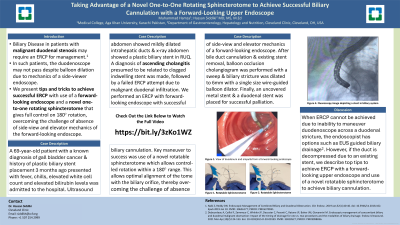Monday Poster Session
Category: Endoscopy Video Forum
P2174 - Taking Advantage of a Novel One-to-One Rotatable Sphincterotome to Achieve Successful Cannulation of the Bile Duct With a Forwarded Looking Upper Endoscope. Top Tips on How to Perform ERCP When Duodenoscope Won't Pass
Monday, October 28, 2024
10:30 AM - 4:00 PM ET
Location: Exhibit Hall E

Has Audio
- HS
Hassan Siddiki, MD
Digestive Disease Institute, Cleveland Clinic
Cleveland, OH
Presenting Author(s)
Muhammad Hamza, 1, Hassan Siddiki, MD2
1Aga Khan University, Karachi, Sindh, Pakistan; 2Digestive Disease Institute, Cleveland Clinic, Cleveland, OH
Introduction: Malignant duodenal stenosis is not uncommon in patients with pancreatic cancer and may require endoscopic retrograde cholangiopancreatography (ERCP) for biliary disease. Mostly, endoscopist can safely pass the standard upper endoscope with or without dilation but due to mechanics of a side-viewer endoscope, despite dilation, duodenoscope may not pass. If stenosis is severe, ERCP could be unsuccessful due to this.We present a video showing successful ERCP with forward looking endoscope including the use of a novel one-to-one rotatable sphincterotome that gives the endoscopist full control on 180-degree rotation, overcoming the challenge of absence of side-view and elevator mechanics.
Case Description/Methods: A 69-year-old patient with fever, chills and elevated white cell count and bilirubin was admitted with a diagnosis of gallbladder cancer and had undergone plastic biliary stent placement at a community hospital three months ago. Ultrasound abdomen showed dilated intrahepatic ducts and x-ray abdomen showed a plastic biliary stent in right upper quadrant. Clinical diagnosis of ascending cholangitis secondary to clogged indwelling plastic biliary stent was made. ERCP failed due to inability to pass a duodenoscope due to malignant infiltration of the duodenum. We performed an ERCP with forward looking upper endoscope with successful removal and replacement with an uncovered metal stent. Key maneuver to success was use of a novel rotatable sphincterotome. This sphincterotome, made to precisely control rotation of the tome with a 180-degree range, allows optimal alignment of the tome with the biliary orifice to achieve successful biliary cannulation. This device overcomes the challenge as the forward-looking upper endoscope neither visualizes the ampulla en face nor has an elevator. After cannulation of the bile duct, the existing biliary stent was removed, balloon occlusion cholangiogram was done with a sweep, biliary stricture was dilated to 6 mm with a low-profile single size wire-guided balloon dilator. Finally, an uncovered biliary metal stent and a duodenal stent was placed for successful palliation.
Discussion: When ERCP cannot be achieved due to inability to maneuver duodenoscope across a duodenal stricture, the endoscopist has options such as endoscopic ultrasound guided biliary draining. However, if the duct is decompressed due to existing stent, we describe top tips to achieve ERCP with a forward-looking upper endoscope and use of a novel rotatable sphincterotome to achieve biliary cannulation.
Disclosures:
Muhammad Hamza, 1, Hassan Siddiki, MD2. P2174 - Taking Advantage of a Novel One-to-One Rotatable Sphincterotome to Achieve Successful Cannulation of the Bile Duct With a Forwarded Looking Upper Endoscope. Top Tips on How to Perform ERCP When Duodenoscope Won't Pass, ACG 2024 Annual Scientific Meeting Abstracts. Philadelphia, PA: American College of Gastroenterology.
1Aga Khan University, Karachi, Sindh, Pakistan; 2Digestive Disease Institute, Cleveland Clinic, Cleveland, OH
Introduction: Malignant duodenal stenosis is not uncommon in patients with pancreatic cancer and may require endoscopic retrograde cholangiopancreatography (ERCP) for biliary disease. Mostly, endoscopist can safely pass the standard upper endoscope with or without dilation but due to mechanics of a side-viewer endoscope, despite dilation, duodenoscope may not pass. If stenosis is severe, ERCP could be unsuccessful due to this.We present a video showing successful ERCP with forward looking endoscope including the use of a novel one-to-one rotatable sphincterotome that gives the endoscopist full control on 180-degree rotation, overcoming the challenge of absence of side-view and elevator mechanics.
Case Description/Methods: A 69-year-old patient with fever, chills and elevated white cell count and bilirubin was admitted with a diagnosis of gallbladder cancer and had undergone plastic biliary stent placement at a community hospital three months ago. Ultrasound abdomen showed dilated intrahepatic ducts and x-ray abdomen showed a plastic biliary stent in right upper quadrant. Clinical diagnosis of ascending cholangitis secondary to clogged indwelling plastic biliary stent was made. ERCP failed due to inability to pass a duodenoscope due to malignant infiltration of the duodenum. We performed an ERCP with forward looking upper endoscope with successful removal and replacement with an uncovered metal stent. Key maneuver to success was use of a novel rotatable sphincterotome. This sphincterotome, made to precisely control rotation of the tome with a 180-degree range, allows optimal alignment of the tome with the biliary orifice to achieve successful biliary cannulation. This device overcomes the challenge as the forward-looking upper endoscope neither visualizes the ampulla en face nor has an elevator. After cannulation of the bile duct, the existing biliary stent was removed, balloon occlusion cholangiogram was done with a sweep, biliary stricture was dilated to 6 mm with a low-profile single size wire-guided balloon dilator. Finally, an uncovered biliary metal stent and a duodenal stent was placed for successful palliation.
Discussion: When ERCP cannot be achieved due to inability to maneuver duodenoscope across a duodenal stricture, the endoscopist has options such as endoscopic ultrasound guided biliary draining. However, if the duct is decompressed due to existing stent, we describe top tips to achieve ERCP with a forward-looking upper endoscope and use of a novel rotatable sphincterotome to achieve biliary cannulation.
Disclosures:
Muhammad Hamza indicated no relevant financial relationships.
Hassan Siddiki: Boston Scientific consulting – Consultant.
Muhammad Hamza, 1, Hassan Siddiki, MD2. P2174 - Taking Advantage of a Novel One-to-One Rotatable Sphincterotome to Achieve Successful Cannulation of the Bile Duct With a Forwarded Looking Upper Endoscope. Top Tips on How to Perform ERCP When Duodenoscope Won't Pass, ACG 2024 Annual Scientific Meeting Abstracts. Philadelphia, PA: American College of Gastroenterology.
